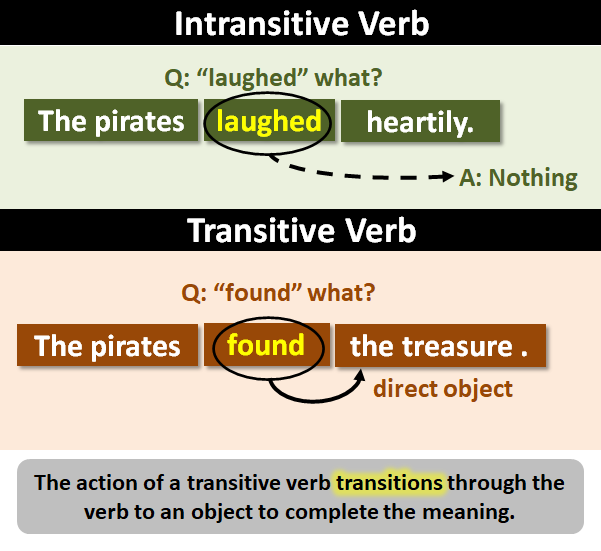ref –
- https://www.grammar-monster.com/glossary/intransitive_verbs.htm
- https://www.scribbr.com/verbs/intransitive-verb/
What Is an Intransitive Verb?
An intransitive verb is a verb that does not take a direct object.
In other words, the action of an intransitive verb is not done to someone or something.
It involves only the subject.
For example:
Sarah laughed.
(“Laughed” is an intransitive verb. The action of the verb only involves Sarah.)
The opposite of an intransitive verb is a transitive verb. A transitive verb can have a direct object.
Sarah ate an apple.
(“Ate” is a transitive verb. The action of the verb was done to something (“an apple”), which is the direct object.)

What Does “Taking a Direct Object” Mean?
An intransitive verb does not take a direct object. Here’s a bit more on what that means:
He laughed.
(Laughed is an intransitive verb. It has no direct object. You cannot laugh something.)
He told a joke.
(Told is a transitive verb. The direct object is a joke. You can tell something. For example, you can tell a story, a lie, a joke, etc.)
You can find the direct object of a verb by reading the verb and then asking “what?” (or “whom?”).
If this question seems inappropriate, then you’re probably dealing with an intransitive verb. For example (verbs shaded):
He caught the bus after the party.
(Q: Caught what? A: the bus. This is a transitive verb. It has a direct object.)
He disappeared after the party.
(Q: Disappeared what? That doesn’t make sense. You can’t disappear something.
This is an intransitive verb. It can’t take a direct object.)
Examples of Intransitive Verbs
Here are some more examples of intransitive verbs. With each example, if you read the verb (shaded) aloud and ask “what?”, there will be no answer. There is no answer because there is no direct object. These verbs are all intransitive.
Every single person voted.
The jackdaws roost in these trees.
The crowd demonstrated outside the theatre.
(In this example, demonstrated is an intransitive verb. However, to demonstrate can be used transitively too, e.g., He demonstrated a karate chop to the class.)
Verbs That Are Transitive and Intransitive
Some verbs can be transitive and intransitive.
For example:
Mel walks for miles.
(As walks is not being done to anything, this verb is intransitive.)
However, compare it to this:
Mel walks the dog for miles
(This time, walks does have a direct object (the dog). Therefore, it is transitive. Some verbs can be both intransitive and transitive, depending on the usage.)
Here is another example:
The apes played in the woods.
(Played what? Nothing, intransitive)
The apes played hide and seek in the woods.
(transitive)
(Q: played what? A: hide and seek.)
Never followed by an Object
While intransitive verbs are never followed by an object,
they can be followed by modifiers such as
- adverbs
- adverbial clauses
- prepositional phrases
that indicate where, when, or how something occurs.
Ravi jumped.
Leonardo is sleeping soundly.
Marie exercises as often as she can.
Lisa will meditate in the garden.